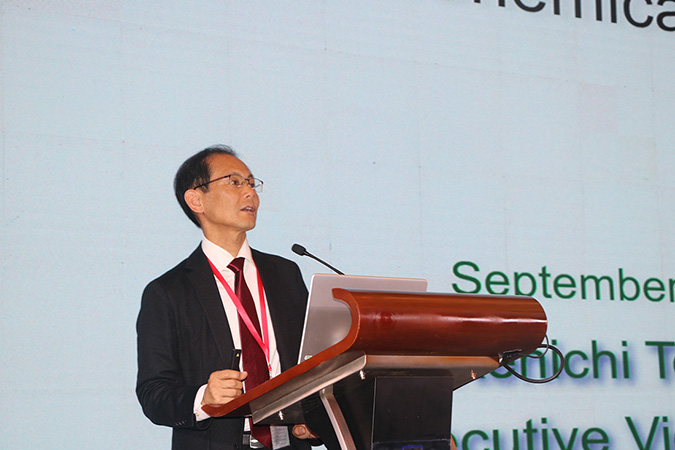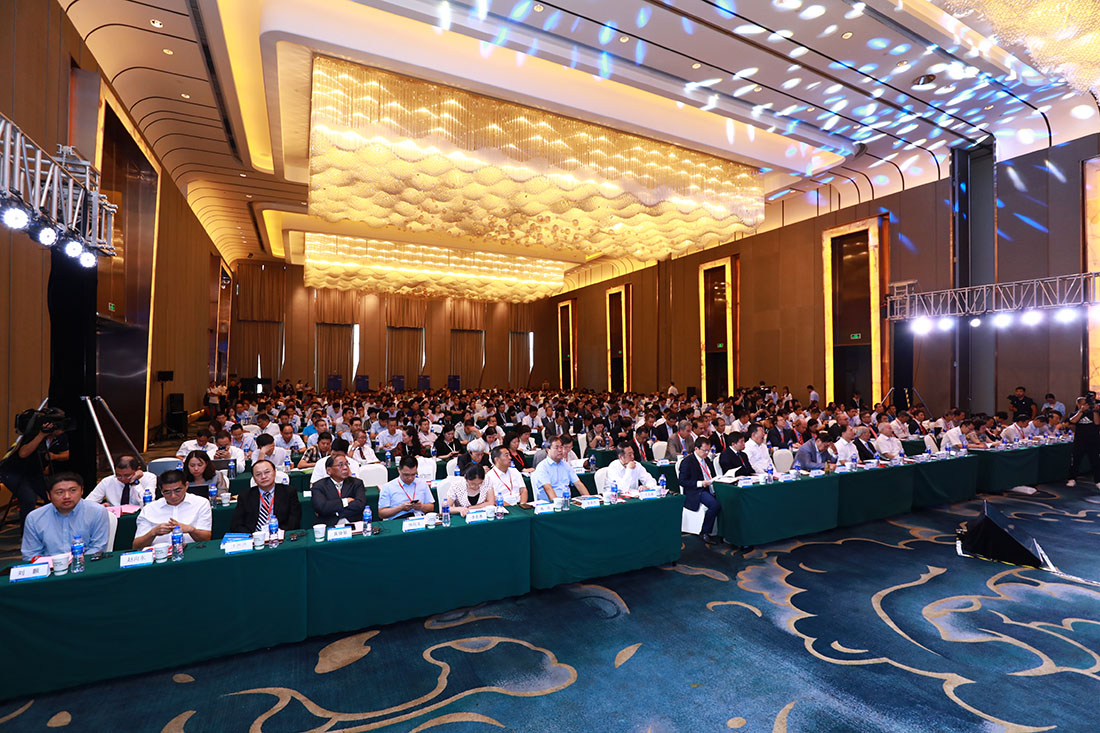At the 25th China International Manmade Fiber Conference (CIMFC), 4-5 Sept. in Bengbu City, Anhui Province, China, experts and executives spoke about advanced materials, new manufacturing technologies, investment, and fashion trends relevant to the manmade fiber industry. Based on the talks at the conference, it is clear that advanced materials are expected to boost the global manmade fiber industry in the next few years.
Attendees & event details
About 600 fiber professionals from more than 20 countries attended the 25th CIMFC for two days of programming. Attendees were primarily from mainland China, with representatives from the United States, Germany, France, the United Kingdom, Japan, South Korea, Thailand, Taiwan, India, Thailand, Indonesia, also in attendance.
The conference was organized by the China National Textile & Apparel Council (CNTAC), the China Chemical Fibers Association (CCFA), the China Textile International Exchange Center (CTIEC), and the China BBCA Group Corp. (BBCA), a Bengbu-headquartered biochemical company, which is expanding to bio-based fiber industry. The Bengbu municipal government and Oerlikon also sponsored the event.
The event featured a development forum and five parallel sessions. The development forum presented the main trends of the manmade fiber industry in China, India, South Korea, Pakistan, Taiwan, Japan and other places in the world. The five parallel sessions included a bio-based material and advanced/functional fiber session, a high-tech fiber session, a green fiber session, a frontier fiber session, and a fashion trend session. More than 50 experts, executives, and officials spoke in the development forum and the parallel sessions.
Global manmade fiber market and forecast
In the development forum, Kenichi Tomiyoshi, executive vice president of Japan Chemical Fibers Association (JCFA), analyzed the supply and demand trend and the challenges of the global fiber industry. Tomiyoshi forecasted the global consumption of different types of fibers through 2022 based on trends of population and per capita fiber consumption. He predicted that global consumption of synthetic fibers and cellulosic fibers will grow at compound annual growth rate (CAGR) of 4.0% to reach 75.9 million metric tons and 3.1% to reach 6.2 million metric tons, respectively, from 2017 through 2022. In the same period, global consumption of cotton will have a CAGR of -0.5%, which means cotton consumption will decline from 26.9 million to 26.3 million metric tons per year. Other natural fibers are also expected to experience slow growth or decline through 2022, yielding a larger share of the market to manmade fibers, according to Tomiyoshi.
Tomiyoshi said the overcapacity in the synthetic fiber section will ease by 2022. In 2014, the world produced 56 million metric tons of synthetic fibers out of a total capacity of 81 million metric tons – the operating rate was only 69.1%. From 2015 to 2017, though the consumption kept rising, production also expanded, resulting in a low operating rate ranging from 69.3% to 71.5%. However, the operating rate is likely to grow to 76.5% by 2022, when 75.9 million metric tons are produced from a total capacity of 99.2 million metric tons, according to Tomiyoshi.
Most conventional manmade fibers will have slow growth, while some others, especially bio-based, advanced, functional and high-performance fibers, will grow faster than the global average and become the main growth engine for the fiber industry in the near term, according to Tomiyoshi. These fast-growing fiber types were a main talking point during the five parallel sessions at CIMFC.

Bio-based polylactic acid fibers in Bengbu and worldwide
This was the first time the conference was held in Anhui Province in the 34-year history of CIMFC (and its predecessor the Beijing International Conference on Man-made Fibers), which was first held in 1985 when China just started to open its manmade fiber market to the outside world. Anhui is not among China’s largest manufacturing provinces for manmade fibers. In 2018, Anhui produced a total of nearly 396,100 metric tons of chemical fibers, taking only 0.8% of China’s total production of 50.1 million metric tons. However, Anhui is a leader in several types of advanced materials and technologies. Bengbu, the largest harbor city along the Huai River, aims to become China’s “capital” of advanced materials. The city expects to create annual revenues of over one hundred billion yuan ($14 billion) of bio-based materials in the near future.
To achieve this goal, the Bengbu-based BBCA and the Belgium-headquartered Galactic invested a total of 8 billion yuan ($1.1 billion) on a polylactic acid (PLA) plant with an annual capacity of one million metric tons. At the same time, BBCA also works with China High-Tech Group Corp. (High-Tech), one of the world’s largest providers for textile and manmade fiber manufacturing solutions, to invest 2 billion yuan ($280 million) to set up a facility with a capacity of 300,000 metric tons of PLA fibers per year. The two projects are expected to generate total revenues of 40 billion yuan ($5.6 billion) per year when they are fully completed and launched, achieving 40% of the city’s bio-based material goal. With these ambitious plans, the local government and BBCA jointly hosted the 25th edition of the CIMFC in Bengbu with other organizers.
PLA is a bio-based and biodegradable material with antibacterial, anti-mite, and ultraviolet-resistant, as well as other, benefits. It is one of a few bio-based polymers that has been put into large-scale commercialized production. According to BCC Research, a Wellesley, Massachusetts-based market research firm, the global consumption of PLA will grow at a CAGR of 9.9% from around 402,000 metric tons in 2018 to 645,000 metric tons in 2023. At this speed, the global demand will overtake one million metric tons by 2028.
BBCA’s ambitious plans for PLA production will likely be challenged by limited global demand, considering the first-phase of its PLA project is planned to be completed in 2021 with an annual capacity of 300,000 metric tons. At that point, BBCA’s capacity will account for more than half of the global demands based on BCC Research’s data. Currently, main players of PLA include the U.S.-based NatureWorks, the Netherlands-based Corbion, the China-based Supla, and the Germany-based Pyramid plastics. Their capacity ranges from 50,000 to 150,000 metric tons per year. Galactic, BBCA’s business partner only has a capacity of 1,500 metric tons per year from the Belgian company’s joint venture with Total Petrochemicals.
Historically, there were also some setbacks that slowed down the bio-polymer and PLA market after a burst of intensive investment on new projects. The setbacks in recent years include:
- Delays in implementation of the bio-polymer regulations in Europe
- Lack of traction of bio-polymer demand in several important regional markets such as the U.S.
- Change of focus. For example, intentions to increase production capacities for bio-based PET have not been realized at the rate predicted in previous years. The packaging industry may shift to other bioplastics such as polyethylene furanoate (PEF), a new polymer comparable to PET, but 100% bio-based that could enter the market by 2020. This means a new bio-based material with better overall performance could totally phase out an old one in just one or two years.
So although PLA has a high possibility to grow much faster than the average of manmade fiber industry, it is still too early to say if BBCA’s expansion plan will succeed and change the global image of the PLA or bio-based fibers industry in the next few years. But BBCA is now actively exploring as many industrial applications as possible to expand the end-user markets for PLA fibers.
Chen Zhongbi, general manager of the PLA business unit of BBCA, introduced current advances in his company’s applications of PLA fiber, woven PLA fabric, and nonwoven PLA fabric during a CIMFC session. He said BBCA had developed a series of textile products from woven PLA, including shirts, t-shirts, pajamas, children clothes, socks, and beddings. In addition, several other applications for PLA fibers and nonwoven PLA are also being developed, including:
- Single-component or bio-component PLA fibers can be used to produce spunlace, needle-punched, hot-air, and thermal-bonding nonwoven for various applications such as medical dressings, diapers, and facial masks.
- PLA fibers can be used directly as a filling material in pillows, plush toys, mattress and other products.
- Short PLA fibers (3-6 millimeters) are added to pulps to make functional papers.
- Cigarette filters … BBCA has set up a pilot production line with annual capacity of 200 metric tons of PLA cigarette filters.
Other bio-based and advanced fibers
Other bio-based fibers with strong growth potentials were also discussed at CIMFC. Professor Xia Yanzhi of College of Materials Science and Engineering, Qingdao University, spoke about recent advances of bio-based fibers in biomedical applications. He said four types of bio-based fibers have been successfully used in biomedical applications, including cellulose fibers, chitin/chitosan fibers, silk fibroin, and alginate fibers. Prof. Xia’s team has done a series of research projects, proving that PLA fibers have excellent antibacterial and anti-influenza virus properties for biochemical applications. His team also developed a series of manufacturing technologies for making alginate fibers and finished products.
“Our alginate fiber dressings have obtained FDA qualifications in the United States and Japan and Class I and Class II qualifications of China’s FDA. They have been produced and sold in the Chinese market,” said Prof. Xia.
As alginate fiber is rich in raw materials, it has a strong supply base. “China and Indonesia’s algae aquaculture volumes were, respectively, 13,326,315 metric tons and 10,076,992 metric tons per year,” said Prof. Xia. Also according to BCC Research, the global consumption of bio-based polymers for medical applications will grow at a high CAGR of 11.0% from 2018 through 2023 and reach 26,100 metric tons. Bio-based medical fibers will grow at a similar rate to bio-based polymers. So again, bio-based medical fibers are very likely to grow much faster than the manmade fibers’ average.
In addition to bio-based fibers, experts also discuss other types of advanced fibers in the conference, including nano-tube reinforced carbon fibers, multi-dimensional carbon fiber reinforced polymer (CFRP) composites, and responsive smart fibers. These advanced materials will also have strong growth due to their excellent performance in a wide range of applications such as aerospace, automobile, medicine, filtration and high-end garment fabric.


